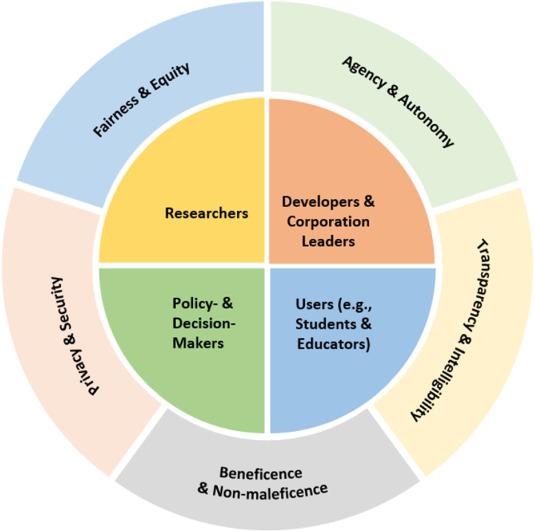The Ethical Considerations of AI in Education: Navigating Challenges and Opportunities
Discover the key ethical implications of artificial intelligence (AI) in education, from data privacy to bias and equitable access, and how schools can harness the power of AI responsibly for better learning outcomes.
Introduction
In today’s rapidly evolving digital landscape, artificial intelligence (AI) in education is revolutionizing classrooms, empowering teachers, and personalizing learning for students at unprecedented scales. However,as AI becomes an integral part of educational ecosystems,it brings along a myriad of ethical considerations that cannot be overlooked. From concerns about data privacy and algorithmic bias to challenges surrounding transparency and equitable access, the embrace of AI in education calls for a thoughtful, principled approach. This article delves into the moast pressing ethical aspects of AI in education, examines both challenges and opportunities, and offers practical guidance for educators, policymakers, and technologists seeking to cultivate responsible and impactful learning environments.
What is AI in Education?
AI in education refers to the implementation of machine learning,natural language processing,and intelligent automation technologies in learning environments. Common applications include:
- Adaptive learning platforms that tailor content to individual students
- Automated grading and assessment tools
- Chatbots for student support and tutoring
- Predictive analytics for student performance and retention
- Curriculum design and content generation
these innovations have the potential to transform education, but not without raising critical ethical questions.
The core Ethical Considerations of AI in Education
Ensuring that AI-driven educational technologies are used responsibly requires careful attention to several interconnected ethical domains:
1. Data Privacy and Security
-
student Data Protection:
collecting and analyzing vast amounts of student data (performance, behaviour, even biometrics) magnifies risks of data breaches and misuse.
-
Compliance:
AI systems must adhere to regulations such as GDPR and FERPA.
-
Informed Consent:
Students and parents should be aware of how data is collected, used, and stored.
2. Algorithmic Bias and Fairness
-
Pre-existing Bias:
AI models can unintentionally perpetuate biases present in historical data, adversely affecting underrepresented groups.
-
Fair Access:
Ensuring AI-driven educational tools do not amplify inequities in learning outcomes.
3. transparency and Explainability
-
Black Box Models:
Many AI systems lack transparency, making it challenging for educators or students to understand how decisions are made.
-
Accountability:
Stakeholders must be able to challenge or appeal decisions made by AI algorithms.
4. Human Autonomy and Teacher Roles
-
Decision Making:
Over-reliance on AI tools may limit teacher autonomy or marginalize their expertise.
-
Augmentation,Not Replacement:
AI should enhance,not replace,the vital human aspects of teaching.
5. Digital Divide and Accessibility
-
Equal Opportunities:
Ensuring all students,regardless of socioeconomic status,have access to AI-powered resources.
-
Inclusive Design:
AI systems must be accessible to learners with diverse needs and disabilities.
AI in Education: Opportunities and Benefits
Despite the challenges, AI also unlocks significant opportunities for improving education:
- Personalized Learning: AI can adapt to individual student needs, learning styles, and progress, making education more effective and engaging.
- Automated Administrative Tasks: Reducing teacher workload through AI-driven grading and scheduling frees up time for direct student interaction.
- Real-Time Feedback: Students receive immediate feedback, enabling faster progression and deeper understanding.
- Early Identification of Learning Gaps: Predictive analytics help educators intervene early, supporting at-risk students.
- Enhanced Accessibility: AI-powered tools (like speech-to-text or adaptive content) improve inclusivity for all learners.
Case Studies: Ethical AI in Real-World Educational Settings
Case Study 1: Bias in Automated Grading Systems
An AI essay grading platform implemented in a US school district was found to score students from certain backgrounds systematically lower, due to biased training data. After examination, the district revised its policies by:
- Engaging external auditors to assess bias in algorithm outcomes
- Providing transparency reports to parents and educators
- Involving diverse educators in ongoing oversight
Case Study 2: Improving Access with AI Tutoring
A nonprofit in India deployed AI-powered chatbots to deliver after-school help in regional languages, helping bridge the resource gap in rural communities. key ethical steps taken included:
- partnering with local stakeholders for culturally relevant content
- Ensuring strict data privacy measures were in place
- Collecting regular feedback from students and educators to improve fairness
Best Practices for Navigating Ethical Challenges
Education leaders, developers, and teachers can foster responsibly designed AI by embracing the following best practices:
- Adopt Obvious Policies: Clearly communicate the use, purpose, and implications of AI to all stakeholders.
- Prioritize Privacy: Implement state-of-the-art security and ensure compliance with educational data regulations.
- Audit for Bias: Routinely review AI systems to surface and correct bias, especially for marginalized or underrepresented groups.
- Empower Educators: Provide training so that teachers can critically engage with AI and retain professional agency in the classroom.
- Design for inclusion: Involve students, families, and individuals with disabilities in development and testing phases.
- Establish Accountability Mechanisms: Make it easy for users to appeal AI-driven decisions or raise concerns.
Practical Tips for Educators and Schools
-
Stay Informed:
Keep up with the latest research, guidelines, and ethical frameworks (e.g., UNESCO’s AI in Education guidelines).
-
Encourage Digital Literacy:
Teach students about how AI works, including its limitations and potential biases.
-
Evaluate Vendors Cautiously:
Ask questions about data privacy, model fairness, and transparency before adopting new AI products.
-
Create Feedback loops:
Solicit opinions from students, families, and teachers to continuously improve AI usage.
Conclusion: Charting a Responsible Path Forward
The ethical considerations of AI in education demand ongoing vigilance and thoughtful collaboration among educators, technologists, policymakers, and learners. As the promise of AI – from personalization to increased access – becomes reality, so too must our commitment to fairness, transparency, and student wellbeing.By proactively addressing data privacy, algorithmic bias, and inclusion, we can harness the full power of AI to create ethical, innovative, and equitable educational experiences for all. Let’s work together to turn AI’s challenges into opportunities that inspire the next generation of learners.

